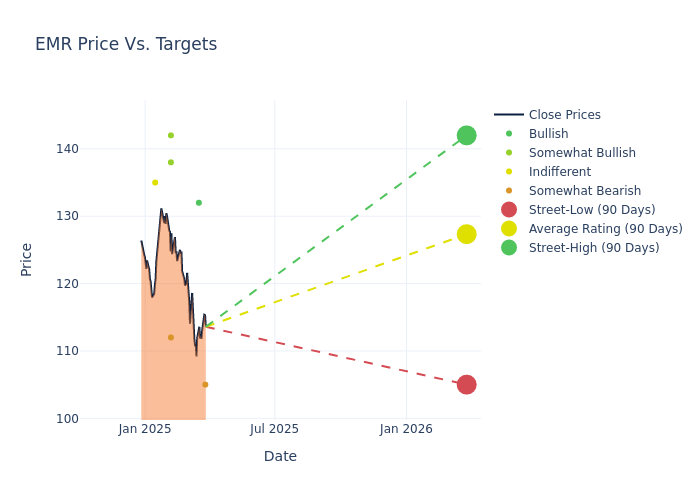Forecasting The Future: 8 Analyst Projections For Emerson Electric
In the latest quarter, 8 analysts provided ratings for Emerson Electric (NYSE:EMR), showcasing a mix of bullish and bearish perspectives.
In the table below, you'll find a summary of their recent ratings, revealing the shifting sentiments over the past 30 days and comparing them to the previous months.
| Bullish | Somewhat Bullish | Indifferent | Somewhat Bearish | Bearish | |
|---|---|---|---|---|---|
| Total Ratings | 1 | 3 | 1 | 3 | 0 |
| Last 30D | 0 | 0 | 0 | 1 | 0 |
| 1M Ago | 1 | 0 | 0 | 1 | 0 |
| 2M Ago | 0 | 2 | 0 | 1 | 0 |
| 3M Ago | 0 | 1 | 1 | 0 | 0 |
Providing deeper insights, analysts have established 12-month price targets, indicating an average target of $126.75, along with a high estimate of $142.00 and a low estimate of $105.00. A decline of 2.5% from the prior average price target is evident in the current average.

Breaking Down Analyst Ratings: A Detailed Examination
The standing of Emerson Electric among financial experts is revealed through an in-depth exploration of recent analyst actions. The summary below outlines key analysts, their recent evaluations, and adjustments to ratings and price targets.
| Analyst | Analyst Firm | Action Taken | Rating | Current Price Target | Prior Price Target |
|---|---|---|---|---|---|
| Julian Mitchell | Barclays | Lowers | Underweight | $105.00 | $110.00 |
| Andrew Kaplowitz | Citigroup | Announces | Buy | $132.00 | - |
| Julian Mitchell | Barclays | Lowers | Underweight | $110.00 | $135.00 |
| Deane Dray | RBC Capital | Maintains | Outperform | $138.00 | $138.00 |
| Joseph O'Dea | Wells Fargo | Raises | Overweight | $142.00 | $140.00 |
| Chris Snyder | Morgan Stanley | Raises | Underweight | $112.00 | $105.00 |
| Stephen Tusa | JP Morgan | Lowers | Neutral | $135.00 | $137.00 |
| Joseph O'Dea | Wells Fargo | Lowers | Overweight | $140.00 | $145.00 |
Key Insights:
- Action Taken: Analysts respond to changes in market conditions and company performance, frequently updating their recommendations. Whether they 'Maintain', 'Raise' or 'Lower' their stance, it reflects their reaction to recent developments related to Emerson Electric. This information offers a snapshot of how analysts perceive the current state of the company.
- Rating: Analyzing trends, analysts offer qualitative evaluations, ranging from 'Outperform' to 'Underperform'. These ratings convey expectations for the relative performance of Emerson Electric compared to the broader market.
- Price Targets: Analysts set price targets as an estimate of a stock's future value. Comparing the current and prior price targets provides insight into how analysts' expectations have changed over time. This information can be valuable for investors seeking to understand consensus views on the stock's potential future performance.
Considering these analyst evaluations in conjunction with other financial indicators can offer a comprehensive understanding of Emerson Electric's market position. Stay informed and make well-informed decisions with our Ratings Table.
Stay up to date on Emerson Electric analyst ratings.
Delving into Emerson Electric's Background
Founded in 1890 as the first manufacturer of electric fans in North America, Emerson Electric has become a leading industrial automation player through the acquisition of established brands. Emerson organizes its business into seven segments that sell a wide range of automation software, power tools, and automation hardware such as valves, gauges, and switches. In recent years, Emerson divested its climate technology and consumer businesses to become more of a pure-play industrial automation company. The automation of a factory is an enticing long-term proposition for manufacturers, helping reduce accident rates and raise uptime and productivity.
Financial Milestones: Emerson Electric's Journey
Market Capitalization Analysis: Above industry benchmarks, the company's market capitalization emphasizes a noteworthy size, indicative of a strong market presence.
Revenue Growth: Emerson Electric's remarkable performance in 3 months is evident. As of 31 December, 2024, the company achieved an impressive revenue growth rate of 1.41%. This signifies a substantial increase in the company's top-line earnings. As compared to its peers, the revenue growth lags behind its industry peers. The company achieved a growth rate lower than the average among peers in Industrials sector.
Net Margin: The company's net margin is a standout performer, exceeding industry averages. With an impressive net margin of 14.01%, the company showcases strong profitability and effective cost control.
Return on Equity (ROE): The company's ROE is a standout performer, exceeding industry averages. With an impressive ROE of 2.78%, the company showcases effective utilization of equity capital.
Return on Assets (ROA): The company's ROA is a standout performer, exceeding industry averages. With an impressive ROA of 1.35%, the company showcases effective utilization of assets.
Debt Management: The company maintains a balanced debt approach with a debt-to-equity ratio below industry norms, standing at 0.37.
Analyst Ratings: Simplified
Ratings come from analysts, or specialists within banking and financial systems that report for specific stocks or defined sectors (typically once per quarter for each stock). Analysts usually derive their information from company conference calls and meetings, financial statements, and conversations with important insiders to reach their decisions.
Beyond their standard evaluations, some analysts contribute predictions for metrics like growth estimates, earnings, and revenue, furnishing investors with additional guidance. Users of analyst ratings should be mindful that this specialized advice is shaped by human perspectives and may be subject to variability.
Which Stocks Are Analysts Recommending Now?
Benzinga Edge gives you instant access to all major analyst upgrades, downgrades, and price targets. Sort by accuracy, upside potential, and more. Click here to stay ahead of the market.
This article was generated by Benzinga's automated content engine and reviewed by an editor.